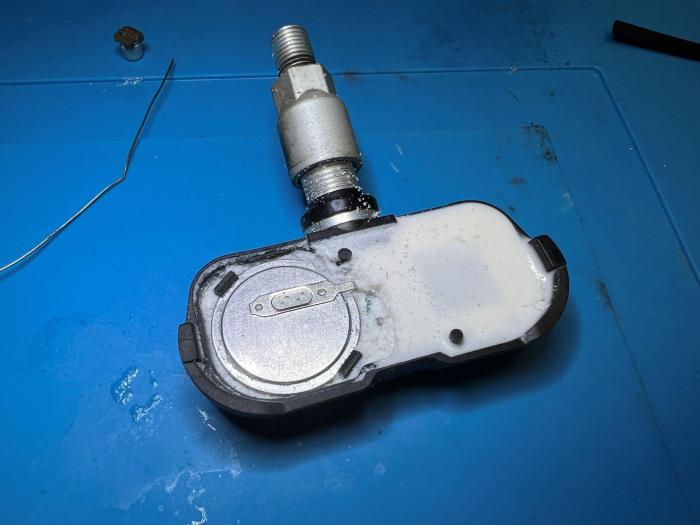Cost to replace TPMS sensors? Yeah, that’s a thing. It’s not exactly the most exciting car repair, but knowing what to expect cost-wise can save you some serious headaches (and maybe even a few bucks). We’re diving deep into the world of tire pressure monitoring systems, breaking down everything from average costs and DIY options to warranty coverage and finding a reliable mechanic.
Get ready to become a TPMS pro!
This guide covers the average costs of TPMS sensor replacement across different car makes and models, factoring in labor and parts. We’ll compare DIY repairs to professional services, explore different sensor types and their lifespans, and offer tips on finding affordable replacement options. We’ll even tackle those tricky warranty questions. Basically, everything you need to know before that dreaded low-pressure light comes on again.
Average Costs of TPMS Sensor Replacement

Replacing a TPMS (Tire Pressure Monitoring System) sensor can be a surprisingly variable expense. Several factors, from the vehicle’s make and model to the location of the sensor and the type of repair shop you choose, all play a role in the final price. This section will break down the average costs and highlight the key elements that influence the overall expense.
Understanding the cost breakdown helps you budget effectively and make informed decisions when dealing with TPMS sensor issues. Whether you’re facing a single faulty sensor or a complete system failure, knowing what to expect can save you time and money.
Average Costs by Vehicle
The cost of replacing a TPMS sensor varies significantly depending on the vehicle. Luxury vehicles and those with more complex sensor systems generally command higher prices. Below is a table showing average costs – remember these are estimates and can fluctuate based on location and other factors.
| Make | Model | Average Cost | Notes |
|---|---|---|---|
| Toyota | Camry | $150 – $250 | Cost can be lower at independent shops. Sensor location relatively easy to access. |
| Honda | CRV | $175 – $300 | Similar to Toyota, but some models may have sensors harder to reach, increasing labor costs. |
| Ford | F-150 | $200 – $350 | Larger trucks often have more robust sensors and may require specialized tools. |
| BMW | X5 | $300 – $500+ | Luxury vehicles often have higher labor rates and more expensive parts. Sensor location can be challenging. |
Labor vs. Parts Costs
The total cost of TPMS sensor replacement is typically divided between labor and parts. Labor costs encompass the mechanic’s time to diagnose the problem, remove the old sensor, install the new one, and program it to the vehicle’s system. Parts costs cover the price of the new TPMS sensor itself.
Generally, labor constitutes a significant portion of the total cost, often ranging from 50% to 70%. For instance, a $200 repair might include $100 for the sensor and $100 for labor. However, this ratio can shift depending on the vehicle’s make and model, the sensor’s location, and the shop’s labor rates.
Factors Affecting Replacement Cost
Several factors can significantly influence the final cost of TPMS sensor replacement. Understanding these factors empowers you to make cost-effective choices.
Choosing an independent mechanic typically results in lower costs compared to a dealership. Dealerships often have higher labor rates. The type of sensor (OEM vs. aftermarket) also plays a role; OEM sensors are usually more expensive but may offer better reliability. Finally, the sensor’s location on the vehicle can impact labor costs; sensors located in difficult-to-reach areas require more time and effort, thus increasing the overall expense.
DIY TPMS Sensor Replacement vs. Professional Service
So, you’ve got a TPMS (Tire Pressure Monitoring System) sensor acting up. Replacing it yourself might seem like a good way to save some cash, but is it really worth the effort? Let’s weigh the pros and cons of DIY versus professional TPMS sensor replacement. We’ll examine the cost-effectiveness, necessary tools and skills, and walk through a DIY process, highlighting potential pitfalls and safety measures.
Cost-Effectiveness of DIY vs. Professional Service
The cost-effectiveness hinges on several factors. A professional mechanic will charge labor fees on top of the sensor cost, typically ranging from $50 to $150 per sensor, depending on location and shop. DIY, however, requires an upfront investment in tools, which can cost anywhere from $50 to $200 depending on the quality and the tools you already own.
If you only need to replace one sensor, the professional route might be cheaper, especially considering the potential cost of mistakes. However, if you need to replace multiple sensors or regularly work on your car, the investment in tools quickly pays for itself. Ultimately, the most cost-effective approach depends on your mechanical aptitude, access to tools, and the number of sensors needing replacement.
Tools and Skills Required for DIY TPMS Sensor Replacement
Successfully replacing a TPMS sensor yourself requires specific tools and some mechanical know-how. You’ll need a tire pressure gauge, a lug wrench, a jack and jack stands (crucial for safety!), a tire iron, valve core removal tool, a torque wrench (essential to avoid damaging the wheel), and potentially a sensor programming tool (depending on the vehicle and sensor type).
Some sensors require specialized tools for removal and installation. You’ll also need to be comfortable with basic automotive repair, understanding how to safely jack up a car, remove and replace a tire, and handle delicate components. If you’re unsure about any of these steps, opting for professional service is always the safer bet.
Step-by-Step Guide for DIY TPMS Sensor Replacement
Before starting, consult your vehicle’s owner’s manual for specific instructions and torque specifications. This is crucial to avoid damaging your wheels or other components.
- Safety First: Park on a level surface, engage the parking brake, and use jack stands to securely lift the vehicle. Never work under a car supported only by a jack.
- Remove the Wheel: Loosen the lug nuts with the lug wrench before jacking up the car. Once lifted, remove the wheel completely.
- Remove the Old Sensor: Use the valve core removal tool to release the valve stem’s pressure. Then, depending on the sensor type, you may need a specialized tool or carefully pry the sensor out. Take note of its position and orientation.
- Install the New Sensor: Carefully insert the new sensor, ensuring it’s properly seated. Tighten the valve core and use the torque wrench to tighten the lug nuts to the manufacturer’s specified torque.
- Reinstall the Wheel: Lower the vehicle, and torque the lug nuts again to ensure they’re properly tightened.
- Program the Sensor (if necessary): Some vehicles require the new sensor to be programmed into the car’s system. This might involve using a specialized tool or visiting a tire shop for programming. Refer to your owner’s manual or consult a professional for guidance on programming.
- Inflate and Check: Inflate the tire to the recommended pressure and check for leaks.
Potential Pitfalls and Safety Precautions
Improperly installing a TPMS sensor can lead to inaccurate pressure readings, potentially compromising safety. Over-tightening the lug nuts can damage the wheel, while under-tightening can lead to wheel detachment. Always consult your vehicle’s owner’s manual for specific torque specifications. Failing to properly program the sensor can result in a persistent malfunction indicator light. Remember, safety is paramount; if you’re uncomfortable with any step, it’s best to seek professional assistance.
Working on a vehicle can be dangerous if proper safety precautions aren’t taken.
Types of TPMS Sensors and Their Costs
Picking the right TPMS sensor can feel like navigating a minefield, especially when you’re trying to balance cost and performance. There are two main types: direct and indirect, each with its own set of pros and cons. Understanding these differences will help you make an informed decision about your vehicle’s tire pressure monitoring system.Direct TPMS sensors are the workhorses of the system.
They’re physically mounted inside each tire and directly measure pressure. This provides precise, real-time data, which is crucial for safety. Indirect systems, on the other hand, infer tire pressure using wheel speed sensors already present in the vehicle’s ABS system. While less expensive upfront, they offer less accurate readings and are slower to detect pressure changes.
Direct TPMS Sensor Types and Costs
Direct TPMS sensors are the gold standard for accuracy and reliability. They come in a variety of designs, impacting both performance and price. Sensor manufacturers use different materials and technologies, resulting in a range of durability and lifespan. For instance, sensors made with higher-quality materials might be more resistant to corrosion and last longer, justifying a higher initial cost.
- OEM Sensors: These are the sensors originally installed on your vehicle by the manufacturer. They’re typically the most expensive option, but they’re guaranteed to be compatible and often come with a longer warranty. Expect to pay anywhere from $50 to $150 per sensor, depending on the make and model of your car.
- Aftermarket Sensors: These sensors are produced by third-party manufacturers and are generally cheaper than OEM sensors. Prices range from $20 to $80 per sensor, but you need to ensure compatibility with your vehicle’s system. Quality can vary considerably, impacting lifespan and accuracy.
- Universal Sensors: Designed to work across multiple vehicle makes and models, these sensors offer flexibility but may require programming for optimal performance. They often fall within the $30-$70 price range per sensor, offering a balance between cost and compatibility.
Indirect TPMS Systems and Their Limitations
Indirect TPMS systems use the Anti-lock Braking System (ABS) sensors to estimate tire pressure. If one tire has significantly lower pressure than the others, the wheel will rotate slightly faster, triggering a warning. These systems are cheaper to implement because they don’t require additional sensors within the tires. However, they’re less precise and can be affected by other factors like uneven road surfaces or tire wear.
They are not as reliable in detecting slow leaks or small pressure variations. While the initial cost is low (incorporated into the ABS system), the lack of precise pressure readings might lead to more frequent tire rotations and inspections, ultimately increasing maintenance costs in the long run. A major disadvantage is their inability to pinpoint which tire is underinflated; they only provide a general warning.
Comparison of TPMS Sensor Features
The following table summarizes the key features, lifespan, and price ranges of the three sensor types discussed above. Keep in mind that these are approximate ranges and actual costs can vary based on your vehicle, location, and retailer.
| Sensor Type | Lifespan (Years) | Accuracy | Price Range ($ per sensor) | Advantages | Disadvantages |
|---|---|---|---|---|---|
| OEM | 5-10 | High | 50-150 | Guaranteed compatibility, longer warranty, high accuracy | Most expensive |
| Aftermarket | 3-7 | Moderate | 20-80 | More affordable | Variable quality, potential compatibility issues |
| Universal | 3-5 | Moderate | 30-70 | Wide compatibility | May require programming, potentially less accurate than OEM |
Factors Influencing TPMS Sensor Replacement Frequency

So, you’ve learned about the costs of replacing those little tire pressure monitoring system (TPMS) sensors. But how long do they actually last? And what can make them bite the dust prematurely? Let’s dive into the lifespan of these crucial components and the factors that influence how often you might need to replace them.Understanding the typical lifespan of a TPMS sensor is key to budgeting for car maintenance.
While manufacturers often aim for a long lifespan, several factors can significantly impact their longevity. Think of it like this: your TPMS sensors are constantly working, silently monitoring your tire pressure and transmitting data to your car’s computer. This constant operation, coupled with exposure to the elements, can take its toll.
Typical Lifespan of TPMS Sensors, Cost to replace TPMS sensors
Most TPMS sensors are designed to last for the life of the vehicle, which is often quoted as around 7-10 years. However, this is under ideal conditions. Real-world factors like extreme temperature fluctuations (think scorching summers and frigid winters), road hazards, and even improper tire rotations can shorten this lifespan considerably. A sensor on a vehicle that frequently travels rough terrain or endures harsh weather conditions might not last as long as one on a car primarily driven on smooth city streets.
For example, a car used primarily for off-roading in the Arizona desert might experience sensor failure sooner than a car driven mostly in suburban Seattle.
Circumstances Leading to Premature TPMS Sensor Replacement
Several things can lead to a TPMS sensor failing before its expected lifespan. Damage from impacts is a common culprit. Curb rash, hitting a pothole hard enough to bend a rim, or even a flat tire that’s improperly repaired can all damage a sensor. Internal malfunctions can also occur; the battery powering the sensor might fail, or the electronic components themselves could malfunction.
This can sometimes be indicated by erratic readings on your dashboard, or a complete failure to display pressure information for a specific tire. For example, a sensor might suddenly stop transmitting data due to a short circuit caused by corrosion from road salt.
Replacing TPMS sensors can be a total wallet-buster, especially if you’re rocking a high-end ride. Before you even think about that expense, though, maybe plan a sweet escape – check out this list of Best road trips for exotic car owners to make sure your fancy wheels are getting some use. Then, after your epic adventure, you can worry about those pesky TPMS sensor costs.
Preventative Measures to Extend TPMS Sensor Lifespan
Taking proactive steps can significantly extend the life of your TPMS sensors. Regular tire rotations are crucial. This ensures even wear and tear, reducing the risk of damage during impacts. Careful driving, especially avoiding potholes and curbs, goes a long way. It might seem obvious, but maintaining proper tire inflation is also vital.
Overinflation or underinflation can stress the tires and indirectly affect the sensors. Finally, when you have your tires changed or serviced, make sure the technician is aware of the TPMS sensors and handles them with care. Damage during tire changes is a surprisingly common cause of premature failure. A technician who’s familiar with the sensors will know to use the correct tools and procedures to avoid accidental damage.
Warranty Considerations and Coverage
Understanding your warranty coverage for TPMS sensors is crucial for managing the cost of replacement. Many factors influence whether a replacement will be covered, and knowing these beforehand can save you money and frustration. This section will explore typical warranty coverage and how it affects your out-of-pocket expenses.Warranty coverage for TPMS sensors varies greatly depending on the manufacturer, the vehicle, and even the specific sensor itself.
Generally, new vehicles come with a comprehensive warranty that covers defects in materials and workmanship for a specified period, often ranging from three to five years. This usually covers the sensors themselves, but may not include damage resulting from accidents, misuse, or wear and tear. Dealerships often offer their own extended warranties that might include TPMS sensor replacement, but these are usually purchased separately and at an additional cost.
Replacing TPMS sensors can be a pricey ordeal, especially if you’re dealing with multiple sensors. It’s definitely a less stressful problem than, say, your car overheating in the middle of rush hour traffic – check out this guide How to fix a car overheating in traffic if that ever happens to you! Anyway, back to those TPMS sensors; getting them replaced at a dealership is usually more expensive than going to an independent mechanic.
Aftermarket sensors typically come with shorter warranties, often just one year, focusing primarily on manufacturing defects.
Manufacturer’s Warranty Coverage
Most vehicle manufacturers include TPMS sensors under the overall vehicle warranty. This means that if a sensor malfunctions due to a manufacturing defect—such as a faulty internal component or a problem with the sensor’s electronic circuitry—during the warranty period, the replacement will be covered. However, it’s essential to note that this usually excludes damage caused by external factors, such as punctures from road debris or damage from a collision.
For example, if a sensor fails because it was hit by a rock, the warranty likely won’t cover the replacement. Conversely, if a sensor fails due to an internal electronic failure, within the warranty period, it should be covered. To determine the specifics of your vehicle’s warranty, consult your owner’s manual or contact your dealership.
Impact of Warranty on Replacement Costs
The existence or absence of warranty coverage significantly impacts the cost of TPMS sensor replacement. If your sensors are still under warranty, replacement is typically free. You may have to pay for diagnostic fees to confirm the sensor failure, but the sensor itself should be replaced at no cost to you. However, if your warranty has expired or doesn’t cover the type of sensor failure you’re experiencing, you’ll be responsible for the full cost of replacement, which can range from a few tens of dollars for a basic sensor to over a hundred dollars for more advanced sensors or those requiring specialized programming.
Examples of Warranty Coverage and Non-Coverage
Let’s consider two scenarios:Scenario 1: A driver notices a TPMS warning light illuminating on their car, which is still under the manufacturer’s 3-year warranty. A diagnostic test reveals a faulty sensor due to a manufacturing defect. In this case, the manufacturer’s warranty should cover the cost of the sensor replacement, likely with only a small diagnostic fee payable by the driver.Scenario 2: A driver hits a pothole, damaging a TPMS sensor on their car.
Their car’s warranty has expired. In this situation, the damage is not covered under warranty because it resulted from external impact. The driver is responsible for the entire cost of the sensor replacement.
Finding Affordable TPMS Sensor Replacement Options: Cost To Replace TPMS Sensors
Replacing TPMS sensors doesn’t have to break the bank. With a little research and smart shopping, you can find affordable options without sacrificing quality or safety. This section will guide you through finding reputable mechanics offering competitive pricing and comparing quotes effectively.Finding a reliable mechanic who offers competitive pricing for TPMS sensor replacement requires a strategic approach. Don’t just settle for the first shop you find; take the time to compare options and ensure you’re getting a fair deal.
This involves utilizing online resources, checking reviews, and directly contacting mechanics for quotes.
Comparing Quotes from Different Service Providers
Before committing to a TPMS sensor replacement, obtaining multiple quotes from different service providers is crucial. This allows for a thorough comparison of pricing, services included, and overall value. For example, you might receive quotes ranging from $50 to $150 per sensor, depending on the type of sensor, labor costs, and the shop’s overhead. To effectively compare, create a simple table listing each provider’s name, price per sensor, total cost (including labor and any additional fees), warranty offered, and estimated completion time.
This structured approach facilitates a clear understanding of the value proposition offered by each service provider. Consider factors beyond just the price, such as the mechanic’s reputation, experience, and customer service.
Questions to Ask Before Choosing a Mechanic
A checklist of pertinent questions will help you make an informed decision. These questions should focus on the mechanic’s experience with TPMS sensors, their warranty policies, the type of sensors they use, and their labor costs. Asking about the specific tools and techniques used for sensor replacement is also important to ensure they are following best practices. Inquiring about their diagnostic process before replacement helps confirm that the sensors actually need replacing and not just a simple tire pressure adjustment.
Finally, check if they offer any discounts or packages for multiple sensor replacements. Asking about customer reviews and testimonials will also provide valuable insight into the mechanic’s reliability and professionalism.
Visual Representation of TPMS Sensor Location and Replacement Process
Understanding the location of your TPMS sensors and the process of replacing them is crucial for maintaining tire pressure monitoring and overall vehicle safety. This section provides a visual guide, focusing on typical sensor placement and the steps involved in a replacement. Remember, always consult your vehicle’s owner’s manual for specific instructions and safety precautions.
TPMS sensors are small, electronic devices that measure tire pressure and transmit that data to your vehicle’s onboard computer. Their location varies depending on the vehicle make and model, but generally follows consistent patterns.
Typical TPMS Sensor Locations
The most common location for TPMS sensors is inside the tire valve stem. However, some manufacturers opt for alternative placements. Understanding these variations can save you time and effort during a replacement.
- Inside the Valve Stem: This is the most prevalent location. The sensor is integrated directly into the valve stem, making it easily accessible during a tire change or sensor replacement.
- Within the Wheel Rim: Less common, but some vehicles, especially those with specialized rims, might house the sensor within the wheel itself. This necessitates wheel removal for access.
- Variations Across Models: The exact placement within the valve stem or rim can subtly differ between car makes and models. For example, a Honda Civic might have a slightly different sensor configuration compared to a Ford F-150.
Steps Involved in TPMS Sensor Replacement
Replacing a TPMS sensor involves several steps, each requiring careful attention to detail. Visualizing these steps can make the process easier to understand, whether you’re doing it yourself or overseeing a professional.
- Deflate the Tire: Completely deflate the tire to safely remove the wheel. Imagine letting all the air out until the tire is completely flat against the rim.
- Remove the Wheel: Loosen the lug nuts and remove the wheel from the vehicle. Picture carefully lifting the wheel off the hub.
- Access the Sensor: Locate the TPMS sensor within the valve stem or the wheel rim. Visualize carefully removing the old sensor, noting its orientation and any clips or retaining mechanisms.
- Install the New Sensor: Carefully install the new TPMS sensor, ensuring it’s securely seated and oriented correctly. Imagine a snug fit, with no gaps or loose connections.
- Re-inflate the Tire: Re-inflate the tire to the recommended pressure. Imagine watching the pressure gauge climb to the correct level.
- Reinstall the Wheel: Carefully reinstall the wheel, ensuring the lug nuts are tightened correctly. Picture the wheel securely back on the vehicle, evenly tightened.
- Program the New Sensor (if necessary): Some vehicles require programming the new sensor to the vehicle’s computer system. This often involves using a specialized tool or visiting a mechanic.
Closing Notes
So, there you have it – a comprehensive look at the cost of replacing TPMS sensors. From understanding the average costs and the different types of sensors to weighing DIY versus professional repair, we’ve covered the bases. Remember, preventative maintenance and knowing your car’s quirks can save you money and frustration in the long run. Now go forth and conquer those tire pressure woes!









